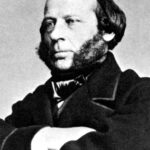“Now comes the reign of iron.”
Less than 1,000 feet south of the Lincoln Memorial at the southern terminus of 23rd St is a forgotten monument honoring the memory of the inventor of the USS Monitor, America’s first ironclad warship. Sitting on a tear-drop-shaped traffic island, John Ericsson’s memorial is cut off from pedestrians and tourists by traffic coming into and out of Arlington.

The circular floor of the memorial is inlaid with bronze to resemble a compass. With a pensive look on his face, the figure of Ericsson is seated upon a rectangular base. On the base stands a circular sculpture of three allegorical figures surrounding Yggdrasil, the Norse tree of life, reflecting Ericsson’s Swedish origins. The three figures represent the qualities that made Ericsson great: a Viking representing Adventure, an iron worker representing Labor, and a female gazing into the distance representing Vision.

The memorial was dedicated in May 1926 but the statue wasn’t completed until the following April. A full-sized plaster replica of the monument painted to resemble what the finished work would look like was used instead. The dedication was held ahead of the completion of the monument to coincide with the visit of the future king of Sweden – Crown Prince Gustavus Adolphus – to Washington, D.C. The Crown Prince and President Coolidge spoke of friendship and the cultural contributions of Swedish Americans to a crowd of 5,000.

Ericsson’s memorial was created by renowned American sculptor James Earle Fraser. Fraser is responsible for many well-known monuments throughout Washington, such as Alexander Hamilton and Albert Gallatin at the U.S. Treasury Building and the Second Division Monument. His most famous work is the Buffalo nickel, which was in circulation between 1913 and 1938.
Ericsson came to the United States in 1839. He had a radical new idea for a propeller design that couldn’t find support in his native Sweden. Fortunately, he made the acquaintance of American naval officer Robert Stockton, who used his political influence to put Ericsson’s ideas into production. Four years later, the USS Princeton – principally designed by Ericsson – was launched. At the time, it was the fastest steam powered ship ever built.

His next great innovation came during the American Civil War. The union army had received word that the Confederates were building an iron-plated ship and put out a call for plans in August 1861. Their urgency was so great that by September Ericsson’s plans had been chosen and construction had begun. The USS Monitor was launched 101 days later. The ship was never formally tested; instead it was sent directly into battle against the ironclad CSS Virginia at the Battle of Hampton Roads. Although the battle ended in a draw – the cannon shot bounced off the armor of each ship – Ericsson’s design had changed to course of naval warfare forever.
Today, Ericsson’s name is largely forgotten, but in his time he was considered a national hero. He donated his many patents for the Monitor – which likely would have made him wealthy – to the United States government, his “contribution to the glorious Union cause.” He died on the 27th anniversary of the Battle of Hampton Roads and his remains were sent back to Sweden aboard the USS Baltimore. More than 100,000 people lined the streets and piers of New York City to pay their respects as his remains were taken aboard the ship.

Resources used for this article:
https://en.wikipedia.org/wiki/John_Ericsson
https://en.wikipedia.org/wiki/John_Ericsson_National_Memorial
https://en.wikipedia.org/wiki/James_Earle_Fraser_(sculptor)
http://query.nytimes.com/mem/archive-free/pdf?res=9F07E5DE103BE533A25757C2A96E9C94619ED7CF


One thought on “John Ericsson”
Comments are closed.